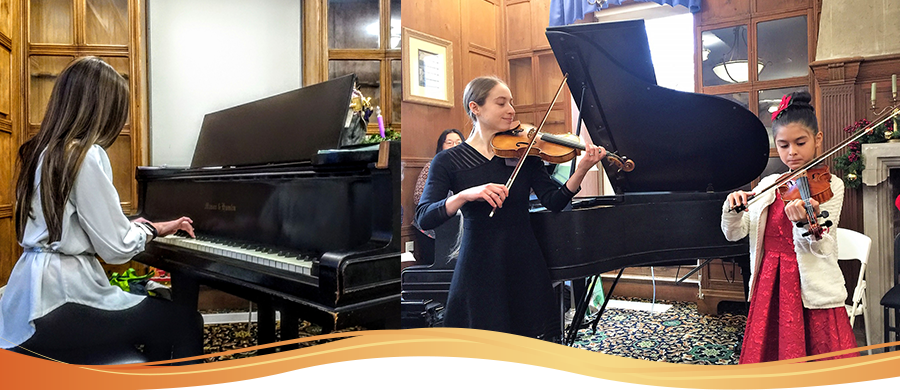
Online
Music for the Community
If you're interested in a particular category, you can sort performances by student age, instrument, singalong music, composer and so on - click on the orange tags under the text. We hope you and your family will enjoy watching our students share their music!
To have each week's videos and accompanying info sent to your inbox*, please subscribe via the orange button.
*Videos are delivered twice weekly; you can unsubscribe at any time, and we will never share or sell your info.
Subscribe to this Page
Displaying items by tag: Violin
Day 33: I Want a Popsicle
Day 33: Violinist age 5 plays Twinkle Variation D, “I Want a Popsicle”
Day 31: Lollipop Man
Violinist age 8 plays "Lollipop Man" by Katherine and Hugh Colledge
Day 30: Mozart Violin Concerto #3 (Skills, part 5)
Violinist age 16 plays Mozart's Violin Concerto #3 in G major, 1st movement
Day 28: Etude by Suzuki (Skills, part 3)
Violinist age 8 plays Etude by Suzuki
Day 27: Go, Tell Aunt Rhody (Skills, part 2)
Violinist age 8 plays Go Tell Aunt Rhody
Day 25: "Spring" from Vivaldi's Four Seasons
Violinist age 9 plays "Spring" from Vivaldi's Four Seasons, first movement
We’ve finally had some great spring days over the past week – we hope you’ve managed to get outside and enjoy them! With spring really getting underway, this seems like the perfect time to offer this beautiful sound picture.
Italian composer Antonio Vivaldi lived from 1678 – 1741 (more or less at the same time as Bach), and his "Four Seasons" violin concertos are among his most beloved compositions. Each movement of each season is paired with a poem, and it’s thought that Vivaldi may have written these too.
Here’s his poem for this first movement of the "Spring" concerto - and where in the video you'll hear the matching music:
Springtime is upon us. [opening theme]
The birds celebrate her return with festive song, [00:36]
and murmuring streams are
softly caressed by the breezes. [1:25]
Thunderstorms, those heralds of Spring, roar, [thunder at 2:03, lightning at 2:06, rain at 2:14 on]
casting their dark mantle over heaven,
Then they die away to silence, [2:43 - 2:53]
and the birds take up their charming songs once more. [2:53]
Painting the full picture takes a lot of notes - you might notice the young violinist moving over from one page to the next a couple of times!
Day 24: Down Pony, Up Pony
Violinist age 5 plays Twinkle Variation C, "Down Pony, Up Pony"
Here is another variation on Twinkle, from one of our young Wayland Rec beginners. Again, this bowing pattern will show up later in much more advanced repertoire.
For violin, viola and cello, we call this variation “DOWN pony, UP pony” to emphasize the alternating direction of the strong bow strokes. Others like to call it “Long, short-short, Long, short-short”, while our Suzuki piano teachers often use “Run Mommy, Run Daddy”. Pick one of these, and see if you can keep up singing it all the way through - or maybe chase Mom and Dad around the house!
Day 20: "Ode to Joy" by Beethoven
Adult violin student plays "Ode to Joy"
Day 19: Schubert Sonatina in D
Violinist age 10 plays Schubert Sonatina in D, third movement
Viennese composer Franz Schubert lived only from 1797 to 1828, but he managed to compose a vast amount of music in that short time – over 600 songs, seven symphonies, a large amount of piano and chamber music (music for a small group of players), operas, and church music.
The 12th of 14 children, his musical gifts were obvious early on. He started piano lessons with his brother at 5, and violin lessons with his father at 8, but he soon outgrew their ability to teach him. After finishing his training he became a schoolteacher and also gave private music lessons, earning just enough money for his basic needs, including clothing, manuscript paper, pens, and ink, but with little to no money left over for luxuries. His life was never easy, but he did have a small circle of admirers in Vienna. Today, though, Schubert is considered one of the greatest composers of Western classical music, and his heartfelt music continues to be popular.
A sonata is a composition for one or two (occasionally three) instruments, frequently including a piano; and a sonatina literally means a “little sonata” – something shorter and easier. The piano is an equal partner here, with each performer taking turns to have the tune or the accompaniment. This lively movement in 6/8 time is based on a gigue, or jig.
Day 17: "Allegretto" by Suzuki
Violinist age 9 plays “Allegretto” by Suzuki
Musical pieces usually have a clear structure somewhat like a Lego building, and when you can begin to hear that, putting them together from their parts is much easier! This one features the Three Bears, and is built in sections like this:
A1
A2 (almost the same, but a different ending)
B (completely different)
A2
Just as in the singalongs on Day 4 and Day 8, you can hear how the same music has (mostly) the same words. We’ve also underlined the A1 and A2 endings, so you can hear the difference between them.
[A1] In a place far away on a hot summer’s day, the three bears’ cabin stood on the edge of a wood.
[A2] In that place far away on that hot summer’s day,the three bears went away for a walk.
[B] First the big Papa Bear, then the kind Mama Bear; far away, with his chair, came the small Baby Bear…..
[A2] In a place far away on a hot summer’s day, the three bears went away for a walk.


